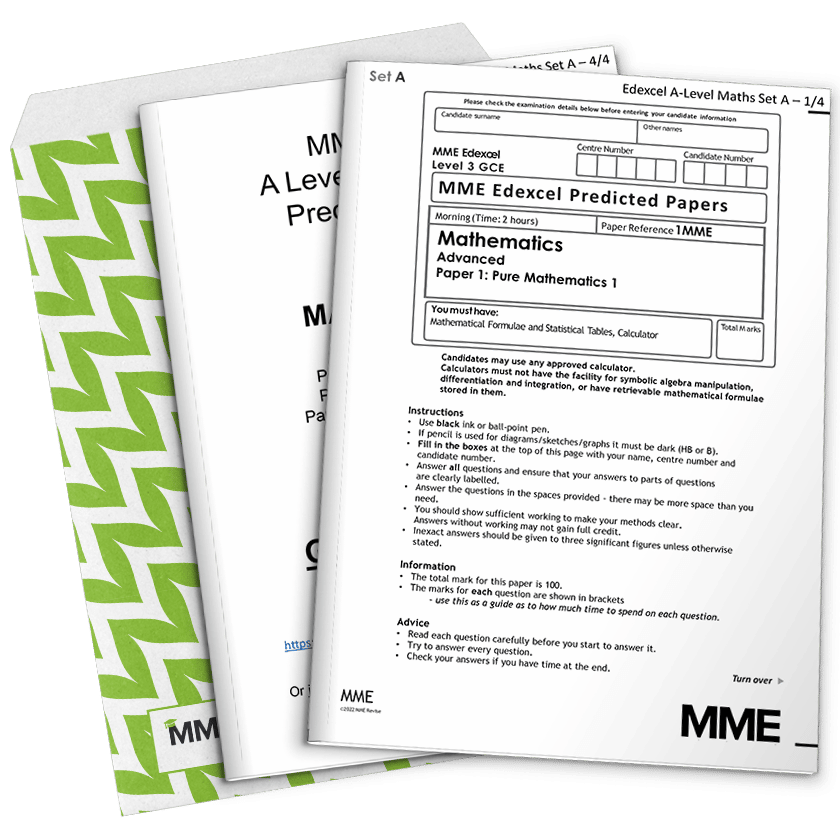R Addition Formulae
R Addition Formulae Revision
R Addition Formulae
We use the R formulae when we have a set of \textcolor{blue}{\sin} and \textcolor{limegreen}{\cos} functions which we want to collect as a single trig function. Essentially, this is the Addition and Double Angle Formulae section, in reverse.
Make sure you are happy with the following topics before continuing.
Origins of the R Formulae
Don’t worry, we’re not teaching you another equation – we’re teaching you a new trick for an old equation.
In the Addition and Double Angle Formulae section, we claimed that we could split \textcolor{blue}{\sin} (\textcolor{purple}{A} \pm \textcolor{orange}{B}) and \textcolor{limegreen}{\cos}(\textcolor{purple}{A} \pm \textcolor{orange}{B}) into separate \textcolor{blue}{\sin} \textcolor{purple}{A}, \textcolor{blue}{\sin} \textcolor{orange}{B}, \textcolor{limegreen}{\cos} \textcolor{purple}{A} and \textcolor{limegreen}{\cos} \textcolor{orange}{B} terms.
We’re now going to look at how to collect a linear combination of those terms into one expression, \textcolor{maroon}{R}\textcolor{blue}{\sin} (\textcolor{purple}{\theta} \pm \textcolor{orange}{\alpha}) or \textcolor{maroon}{R}\textcolor{limegreen}{\cos} (\textcolor{purple}{\theta} \mp \textcolor{orange}{\alpha}).
Using R Formulae
So, let’s say we have a general expression,
a\textcolor{blue}{\sin} \textcolor{purple}{\theta} \pm b\textcolor{limegreen}{\cos} \textcolor{purple}{\theta}
Surely we can express that as
\textcolor{maroon}{R}\textcolor{limegreen}{\cos} \textcolor{orange}{\alpha} \textcolor{blue}{\sin} \textcolor{purple}{\theta} \pm \textcolor{maroon}{R}\textcolor{blue}{\sin} \textcolor{orange}{\alpha} \textcolor{limegreen}{\cos} \textcolor{purple}{\theta}
where a = \textcolor{maroon}{R}\textcolor{limegreen}{\cos} \textcolor{orange}{\alpha} and b = \textcolor{maroon}{R}\textcolor{blue}{\sin} \textcolor{orange}{\alpha}, right?
\textcolor{maroon}{R}\textcolor{limegreen}{\cos} \textcolor{orange}{\alpha} \textcolor{blue}{\sin} \textcolor{purple}{\theta} \pm \textcolor{maroon}{R}\textcolor{blue}{\sin} \textcolor{orange}{\alpha} \textcolor{limegreen}{\cos} \textcolor{purple}{\theta} = \textcolor{maroon}{R}(\textcolor{limegreen}{\cos} \textcolor{orange}{\alpha} \textcolor{blue}{\sin} \textcolor{purple}{\theta} \pm \textcolor{blue}{\sin} \textcolor{orange}{\alpha} \textcolor{limegreen}{\cos} \textcolor{purple}{\theta}) = \textcolor{maroon}{R}\textcolor{blue}{\sin} (\textcolor{purple}{\theta} \pm \textcolor{orange}{\alpha})
Then, we can find a value of \textcolor{orange}{\alpha}, or rather, \textcolor{red}{\tan} \textcolor{orange}{\alpha}, by finding \dfrac{b}{a} = \dfrac{\textcolor{maroon}{R}\textcolor{blue}{\sin} \textcolor{orange}{\alpha}}{\textcolor{maroon}{R}\textcolor{limegreen}{\cos} \textcolor{orange}{\alpha}} = \textcolor{red}{\tan} \textcolor{orange}{\alpha}, so \textcolor{orange}{\alpha} = \tan ^{-1}\dfrac{b}{a}.
We can also find a value of \textcolor{maroon}{R}, by doing the calculation a^2 + b^2 = \textcolor{maroon}{R}^2\textcolor{limegreen}{\cos} ^2 \textcolor{orange}{\alpha} + \textcolor{maroon}{R}^2\textcolor{blue}{\sin} ^2 \textcolor{orange}{\alpha} = \textcolor{maroon}{R}^2(\textcolor{limegreen}{\cos} ^2 \textcolor{orange}{\alpha} + \textcolor{blue}{\sin} ^2 \textcolor{orange}{\alpha}) = \textcolor{maroon}{R}^2, so \textcolor{maroon}{R} = \sqrt{a^2 + b^2}.
Substituting our values of \textcolor{orange}{\alpha} and \textcolor{maroon}{R} gives us an expression for a\textcolor{blue}{\sin} \textcolor{purple}{\theta} \pm b\textcolor{limegreen}{\cos} \textcolor{purple}{\theta} in the form \textcolor{maroon}{R}\textcolor{blue}{\sin} (\textcolor{purple}{\theta} \pm \textcolor{orange}{\alpha}).
We can do a similar process to find an expression in \color{maroon}R\color{limegreen}\cos \color{grey}(\color{purple}\theta \color{grey}\mp \color{orange}\alpha\color{grey}), also.
Factor Formulae
We’ve also got four new formulae…
\textcolor{blue}{\sin} \textcolor{purple}{A} + \textcolor{blue}{\sin} \textcolor{orange}{B} = 2\textcolor{blue}{\sin} \left( \dfrac{\textcolor{purple}{A} + \textcolor{orange}{B}}{2}\right) \textcolor{limegreen}{\cos} \left( \dfrac{\textcolor{purple}{A} - \textcolor{orange}{B}}{2}\right)
\textcolor{blue}{\sin} \textcolor{purple}{A} - \textcolor{blue}{\sin} \textcolor{orange}{B} = 2\textcolor{limegreen}{\cos} \left( \dfrac{\textcolor{purple}{A} + \textcolor{orange}{B}}{2}\right) \textcolor{blue}{\sin} \left( \dfrac{\textcolor{purple}{A} - \textcolor{orange}{B}}{2}\right)
\textcolor{limegreen}{\cos} \textcolor{purple}{A} + \textcolor{limegreen}{\cos} \textcolor{orange}{B} = 2\textcolor{limegreen}{\cos} \left( \dfrac{\textcolor{purple}{A} + \textcolor{orange}{B}}{2}\right) \textcolor{limegreen}{\cos} \left( \dfrac{\textcolor{purple}{A} - \textcolor{orange}{B}}{2}\right)
\textcolor{limegreen}{\cos} \textcolor{purple}{A} - \textcolor{limegreen}{\cos} \textcolor{orange}{B} = 2\textcolor{blue}{\sin} \left( \dfrac{\textcolor{purple}{A} + \textcolor{orange}{B}}{2}\right) \textcolor{blue}{\sin} \left( \dfrac{\textcolor{purple}{A} - \textcolor{orange}{B}}{2}\right)
Example 1: Converting With R Formulae
That might’ve been a lot of information at once, so let’s try an example.
Express 8\textcolor{blue}{\sin} x + 6\textcolor{limegreen}{\cos} x in the form \textcolor{maroon}{R}\textcolor{blue}{\sin} (x + \textcolor{orange}{\alpha}), where 0° \leq \textcolor{orange}{\alpha} \leq 90°.
[4 marks]
Let \textcolor{maroon}{R}\textcolor{limegreen}{\cos} \textcolor{orange}{\alpha} = 8, and \textcolor{maroon}{R}\textcolor{blue}{\sin} \textcolor{orange}{\alpha} = 6.
So, then, \textcolor{maroon}{R}^2 = \textcolor{maroon}{R}^2(\textcolor{limegreen}{\cos} ^2 \textcolor{orange}{\alpha} + \textcolor{blue}{\sin} ^2 \textcolor{orange}{\alpha}) = \textcolor{maroon}{R}^2\textcolor{limegreen}{\cos} ^2 \textcolor{orange}{\alpha} + \textcolor{maroon}{R}^2\textcolor{blue}{\sin} ^2 \textcolor{orange}{\alpha} = 8^2 + 6^2 = 100, giving \textcolor{maroon}{R} = 10.
Also, \textcolor{orange}{\alpha} = \tan ^{-1}(\textcolor{red}{\tan} \textcolor{orange}{\alpha}) = \tan ^{-1} \left( \dfrac{\textcolor{maroon}{R}\textcolor{blue}{\sin} \textcolor{orange}{\alpha}}{\textcolor{maroon}{R}\textcolor{limegreen}{\cos} \textcolor{orange}{\alpha}}\right) = \tan ^{-1} \dfrac{6}{8} = 36.87°.
So, to summarise, we have
8\textcolor{blue}{\sin} x + 6\textcolor{limegreen}{\cos} x = 10\textcolor{blue}{\sin} (x + 36.87°)
Example 2: Converting With R Formulae (Again)
Express 8\textcolor{blue}{\sin} x + 6\textcolor{limegreen}{\cos} x in the form \textcolor{maroon}{R}\textcolor{limegreen}{\cos} (x - \textcolor{orange}{\alpha}), where 0° \leq \textcolor{orange}{\alpha} \leq 90°.
[4 marks]
Let \textcolor{maroon}{R}\textcolor{blue}{\sin} \textcolor{orange}{\alpha} = 8, and \textcolor{maroon}{R}\textcolor{limegreen}{\cos} \textcolor{orange}{\alpha} = 6.
So, then, \textcolor{maroon}{R}^2 = \textcolor{maroon}{R}^2(\textcolor{limegreen}{\cos} ^2 \textcolor{orange}{\alpha} + \textcolor{blue}{\sin} ^2 \textcolor{orange}{\alpha}) = \textcolor{maroon}{R}^2\textcolor{limegreen}{\cos} ^2 \textcolor{orange}{\alpha} + \textcolor{maroon}{R}^2\textcolor{blue}{\sin} ^2 \textcolor{orange}{\alpha} = 6^2 + 8^2 = 100, giving \textcolor{maroon}{R} = 10.
Also, \textcolor{orange}{\alpha} = \tan ^{-1}(\textcolor{red}{\tan} \textcolor{orange}{\alpha}) = \tan ^{-1} \left( \dfrac{\textcolor{maroon}{R}\textcolor{blue}{\sin} \textcolor{orange}{\alpha}}{\textcolor{maroon}{R}\textcolor{limegreen}{\cos} \textcolor{orange}{\alpha}}\right) = \tan ^{-1} \dfrac{8}{6} = 53.13°.
So, to summarise, we have 8\textcolor{blue}{\sin} x + 6\textcolor{limegreen}{\cos} x = 10\textcolor{limegreen}{\cos} (x - 53.13°).
R Addition Formulae Example Questions
Question 1: Convert 5\cos x - 3\sin x into the form R\cos (x + \alpha).
[4 marks]
Let a = 5 = R\cos \alpha and b = 3 = R\sin \alpha.
Then,
R = \sqrt{5^2 + 3^2} = \sqrt{34} and \alpha = \tan ^{-1} \dfrac{3}{5} = 30.96°
Giving
5\cos x - 3\sin x = \sqrt{34}\cos (x + 30.96°)
Question 2: Using factor formulae, convert 6\sin \left( \dfrac{\pi}{4}\right) \sin \left( \dfrac{3\pi}{2} \right) in surd form.
[3 marks]
6\sin \left( \dfrac{\pi}{4}\right) \sin \left( \dfrac{3\pi}{2} \right)
= 3 \times 2\sin \left( \dfrac{3\pi}{2}\right) \sin \left( \dfrac{\pi}{4} \right)
= 3\left( \cos \dfrac{5\pi}{4} - \cos \dfrac{7\pi}{4}\right)
= 3\left( \dfrac{-1}{\sqrt{2}} - \dfrac{1}{\sqrt{2}}\right) = -3\sqrt{2}
Question 3: What are the minimum and maximum values of 3\cos x + 4\sin x?
[2 marks]
We have a = 3 and b = 4.
Then, we have R^2 = a^2 + b^2, or, R = \sqrt{a^2 + b^2} = \sqrt{25} = 5.
Therefore, the minimum and maximum values of 3\cos x + 4\sin x must be -5 and 5.











